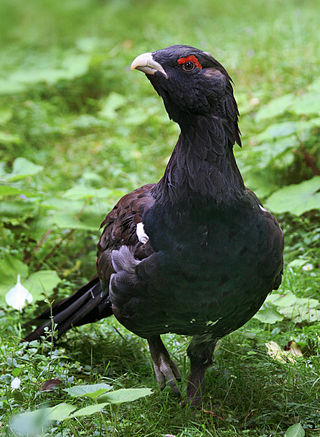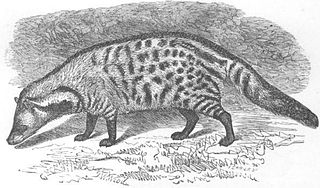Order is one of the eight major hierarchical taxonomic ranks in Linnaean taxonomy. It is classified between family and class. In biological classification, the order is a taxonomic rank used in the classification of organisms and recognized by the nomenclature codes. An immediately higher rank, superorder, is sometimes added directly above order, with suborder directly beneath order. An order can also be defined as a group of related families.

Phoenicopterus is a genus of birds in the flamingo family Phoenicopteridae.

The black-hooded oriole is a member of the oriole family of passerine birds and is a resident breeder in tropical southern Asia from India and Sri Lanka east to Indonesia.

Systema Naturae is one of the major works of the Swedish botanist, zoologist and physician Carl Linnaeus (1707–1778) and introduced the Linnaean taxonomy. Although the system, now known as binomial nomenclature, was partially developed by the Bauhin brothers, Gaspard and Johann, Linnaeus was first to use it consistently throughout his book. The first edition was published in 1735. The full title of the 10th edition (1758), which was the most important one, was Systema naturæ per regna tria naturæ, secundum classes, ordines, genera, species, cum characteribus, differentiis, synonymis, locis or translated: "System of nature through the three kingdoms of nature, according to classes, orders, genera and species, with characters, differences, synonyms, places".

The Cape hare, also called the brown hare and the desert hare, is a hare native to Africa and Arabia extending into India.

Linnaeus's two-toed sloth, also known as the southern two-toed sloth, unau, or Linne's two-toed sloth is a species of sloth from South America, found in Venezuela, the Guyanas, Colombia, Ecuador, Peru, and Brazil north of the Amazon River. There is now evidence suggesting the species' range expands into Bolivia.

The genus Paradisaea consists of six species of birds-of-paradise. The genus is found on the island of New Guinea as well as the nearby islands groups of the Aru Islands, D'Entrecasteaux Islands and Raja Ampat Islands. The species inhabit a range of forest types from sea level to mid-montane forests. Several species have highly restricted distributions, and all species have disjunct distributions. A 2009 study examining the mitochondrial DNA of the family found that the Paradisaea birds-of-paradise were in a clade with the genus Cicinnurus. It showed that the blue bird-of-paradise was a sister taxon to all the other species in this genus.

Tetrao is a genus of birds in the grouse subfamily known as capercaillies. They are some of the largest living grouse.

Viverra is a mammalian genus that was first nominated and described by Carl Linnaeus in 1758 as comprising several species including the large Indian civet. The genus was subordinated to the viverrid family by John Edward Gray in 1821.

Anthropomorpha is a defunct taxon, replaced by Primates.

Conus ebraeus, common name the black-and-white cone or Hebrew cone, is a species of sea snail, a marine gastropod mollusk in the family Conidae, the cone snails and their allies.

Nerita polita is a species of sea snail, a marine gastropod mollusk in the family Neritidae.

Talparia talpa, common name the mole cowry or chocolate banded cowry, is a species of sea snail, a cowry, a marine gastropod mollusk in the family Cypraeidae, the cowries.

Trona stercoraria, common name the rat cowry or droppings cowry, is a species of sea snail, a cowry, a marine gastropod mollusk in the family Cypraeidae, the cowries.

Malea pomum, common name the Pacific grinning tun, is a species of large sea snail, a marine gastropod mollusk in the family Tonnidae, the tun shells.

The 10th edition of Systema Naturae is a book written by Swedish naturalist Carl Linnaeus and published in two volumes in 1758 and 1759, which marks the starting point of zoological nomenclature. In it, Linnaeus introduced binomial nomenclature for animals, something he had already done for plants in his 1753 publication of Species Plantarum.
The Mammalia in the 10th edition of Systema Naturae forms one of six classes of animals in Carl Linnaeus's tenth reformed edition written in Latin. The following explanations are based on William Turton's translations who rearranged and corrected earlier editions published by Johann Friedrich Gmelin, Johan Christian Fabricius and Carl Ludwig Willdenow:
Animals that suckle their young by means of lactiferous teats. In external and internal structure they resemble man: most of them are quadrupeds; and with man, their natural enemy, inhabit the surface of the Earth. The largest, though fewest in number, inhabit the ocean.
In the 10th edition of Systema Naturae, published in 1758, the Swedish naturalist Carl Linnaeus described 554 species of bird and gave each a binomial name.

The 12th edition of Systema Naturae was the last edition of Systema Naturae to be overseen by its author, Carl Linnaeus. It was published by Laurentius Salvius in Holmiæ (Stockholm) in three volumes, with parts appearing from 1766 to 1768. It contains many species not covered in the previous edition, the 10th edition which was the starting point for zoological nomenclature.














